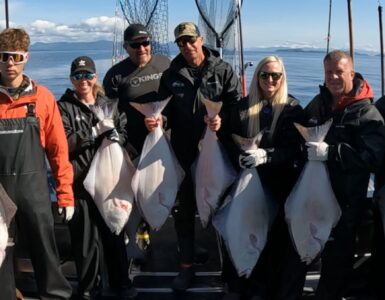(Adam) coming up tonight on KSL Outdoors.
(Audio only) Mountain goats are on the move to southern Utah.
(Adam) A three decade long raptor study continues in the west desert and hunting strutting sharptails in Idaho and in Utah. I’m Adam Eakle and KSL Outdoors, starts right now.
Mountain goats inhabit some of the highest, steepest, and most rugged terrain in Utah, but these goats were taken to a new height during a relocation project conducted on the mountains East of Ogden.
(Leslie) so the first 20 that we are capturing today will go down to Mount Dutton and then another ten will go down to Mount Nebo.
(Darren DeBloois, District Biologist) “This herd in particular doesn’t have a lot of natural predation. It seems like if we didn’t have any hunting pressure or a capture it seems like they would just continue to grow and grow.”
There are about two thousand Mountain goats in Utah, inhabiting several mountain ranges across the state. All of these populations are the result of introductions; the first of which occurred in 1967 when 6 mountain goats were released on Lone Peak.
(Darren) We started this herd with I think seven goats and then we added five a couple of years later. But that’s where they all came from and they just keep growing and growing. They do really well and they do really well up here.
Darren says, they just counted this Willard Peak herd and spotted nearly 200 goats. Their objective is 160, so this relocation project should bring them closer to their goal.
(Darren) they use a Hughes 500 and They chase the goats, shoot a net on.
(Darren) and then a guy they call a mugger in the back will jump out and grab the goat and put hobbles on it’s legs and put a blind fold on.
(Darren) and then they put it in a bag and sling it under the ship and bring it down to us. Where we work it.
Once on the ground, volunteers move them to a area where biologists are waiting to conduct a variety of tests.
(Leslie McFarlane, Wildlife Disease Program Coordinator) we are taking a body weight to judge the condition of the animal and then we take it over and we take some general body measurements. We age the animal.
(Leslie) we take some blood and some nasal and swabs to look for respiratory bacteria.
(Leslie) and then we give them antibiotics and wormers.
(Darren) once we give them some shots and take some blood samples we’ll put them into little boxes. So they don’t have a lot of room to move around. They’ve got some pretty nasty horns so we don’t want them together in a trailer where they can poke each other.
These goats are all going to augment existing populations on Mount Nebo and a range I never knew even had goats, Mount Dutton.
(Dustin Schaible, Wildlife Biologist, DWR) many like me didn’t even know there were goats on the Dutton, where did they come from? (dustin) they’ve just been dispersing over from the adjacent Tushar Mountain range and they’ve done this everytime the Tushar population gets a little bit higher. it’s just the best habitat immediately adjacent, so they just naturally disperse over there and they’ve done it since the late nineties.
(Dustin) the Dutton lacks high elevation habitat, and so it’s not your typical habitat, it’s about as far south as mountain goats will go but thing the dutton has is really rugged terrain and goats are highly associated with escape terrain. Hillsides that are over 30% or steeper. They don’t generally go to far from that stuff and the Dutton is a really rugged place and it’s going to be a pretty good fit for them.
(shorter tag with goat) Mountain goats are a great species to get your kids to go and check out in the wilds. Some of the best places to do it, right here at Willard Peak, the mouth of Little Cottonwood Canyon, down on the Tushars and now, down on the Dutton as well. Time now to check out this weeks edition, of our Burt Brothers quiz question.
(Tonya intro) Welcome back to KSL Outdoors, I’m Tonya Kieffer. For the past several decades, Hawk Watch International has been studying raptor migration across the United States. In the fall, it just happens that the best place to see them is right here in the west desert.
(Guy) One, two, three. Releases the bird.
(William Blake, Lead Bander & Site Coordinator for Goshute Migration Project) Hawk Watch is a non profit. It was started in 1986 by a passionate biologist named Steve Hoffman, who came out to the west after observing hawks.
HawkWatch’s goal is to observe and monitor the trends of migrating raptors as they are good indicators of how an ecosystem is changing, for better or for worse.
(William Blake, Hawk Watch) They come here in high concentrations, in thousands, and you really have no idea, especially here at the Goschutes.
(William Blake, Hawk Watch) In the ’90s They saw up to 26,000 birds. Now I think the migration overall, with all species we see, is around 20,000. We don’t really know why the decline is.
Research performed in the Goshute mountains by HawkWatch International has been crucial to the conservation and preservation of many migrating raptor species, throughout North America.
(Caitlin Davis, Hawk Watch Secondary Bander) This is a giant bottleneck for funneling hawks. We are sampling it by counting and also by banding.
With use of mist nets, Dho-gazza nets, and bow nets, the HawkWatch team is on high alert for a raptor capture.
(Caitlin Davis) So we do use live lures to catch the raptors.
(Caitlin Davis, Hawk Watch) We have the live lures are all attached to a line. It’s kind of like fishing upside down. We attract the raptor with our lure.
(Caitlin Davis, HawkWatch) Male’s coopers hawks are super mouthy.
( Caitlin Davis, Hawk Watch)The most important thing we do is band, because that tracks movements when they get recaptured or found dead somewhere.
After banding, many measurements are taken from the raptors, including weight, wing and tail length,and the birds fat.
(William Blake, Site Coordinator) Most of the data that Hawk Watch gathers is to figure out the trends and also to communicate to other scientists the species diversity that is up here.
Every year, Hawk Watch offers the public the opportunity to be a part of the research, and sometimes, even release a wild bird! According to the researchers, it can become an addiction.
(Caitlin Davis, Secondary Bander) People get addicted to it. Even non biologists.
(Toby Chipman, Field Technician) For me, being a part of researching, holding, learning about interacting with raptors was like a dream come true.
(Tonya tag, toss to fish tech) Fall migration is a great time to experience these raptors, and what a better time then to see them up close and personal if go out to the Goshutes with Hawk Watch. You can check out more on their website at hawkwatch.org. Fall fishing on the other hand is in full swing, and it is time to get out there, so let’s send it back to to the guys in sSalt Lake at Fish Tech, for tonights fishing report.
(Adam) well today we are hunting a bird, I’ll bet you’ve never hunted before, I know I never have. My daughter Taylor you’ve never hunted them and Jeff you’ve never hunted them. (jeff) first time. (adam) brett and angie we are hunting what? (brett) Sharptail grouse. (adam) yeah neat, cool, little birds, they do a cute little strut that Jeff is going to show us a little later. (brett) looking forward to that. (adam) native to Utah? (brett) Native to Utah and the plain states I believe and they are pretty rare here, you have to draw a tag to hunt them. (adam) all of us have drawn tags, we get two apiece. Taylor wanted to ask a question to Brett. (taylor) if they are always here, why do we have to wake up so early. (laughs)
tic hold still bud.
It is early, but the sunrise this morning is well worth getting up for. The peaks are just getting light on them as we head out into the fields.
(Brett) they are really fun to put dogs on, they test a dogs skills. They don’t hold real tight.
(Brett) they are fast flyers, they kind of giggle at you when they fly away so if you miss, it’s sort of like they are making fun of you.
(adam) oh there goes one. (jeff shoots) (brett to Taylor) it’s in your zone, way out in front.
(Jason Robinson, DWR; Upland Game Coordinator) They currently occupy just the northern portion of the state, along the Idaho border.
(Jason) They are a fascinating bird, they attend leks similar to what sage grouse do in the spring. So the males gather and they dance. They have these real elaborate displays that they do for the females.
(File of Sharptail dance)
(Jason) we allocate the permits on the number of sharptail we count in the spring. Then we estimate on how many we think will be there in the fall and allocate based on that.
(Bird gets up) Get it, (shot) (brett) sorry Taylor, I had to try one. Too far for me though.
In Utah you have to draw a permit to hunt sharptails. The limit is two for the season. Today we struggled and only saw a few birds.
(effect)
(Adam) wow look at all those birds.
So we decided to head to Idaho where you can hunt sharptails with an over the counter small game license and here, the limit is two birds per day.
(Brett) let’s walk up this road and try and come over on top of them.
(Brett) seek! (bird gets up, camera to Brett) (shot) nice shot. (brett) fetch.
(Brett) I’ve been coming up here for probably 15 years, the scenery is fantastic and there’s always seems to be a few birds around.
(Bret) good boy, good boy tic.
(Adam) there it is, right, right, right. (shot miss) (adam) left. (shot)
These are flighty birds, they don’t hold long and having a good dog like Tic and plenty of shells is a must.
(jeff another shot and miss and laughs)
(Brett) these ones have Bb’s in them. (laughs)
(Jeff bird) (shots) (adam) there it is, he got him.
(Retrieve) sit, good boy. Jeff, hold. Drop, good boy.
We’re hunting private property that’s accessible to the public here in Idaho through a program called “access yes.” it’s just like our walk in access program here in Utah. To find information on the participating properties check out the Idaho Game and Fish website.
(bird gets up) (brett) oh there it goes. (ADAM SHOT) (jeff) nice shot Adam.
(Adam) Pretty hard flying birds. (jeff) Yeah they spooked a little early but we got our birds today. (adam) pretty fun to shoot a native species here in the West. The sharptail grouse, get out and give them a try, great for kids and even new comers like us. (jeff) that’s right. (adam) from one species to another let’s check out this weeks edition of our Utah Field Guide.







Add comment